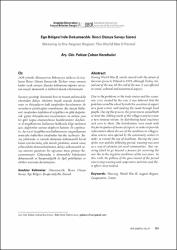| dc.contributor.author | Çoban Karabulut, Pakize | |
| dc.date.accessioned | 2021-01-21T09:49:58Z | |
| dc.date.available | 2021-01-21T09:49:58Z | |
| dc.date.issued | 2017 | en_US |
| dc.identifier.citation | Çoban Karabulut, P. (2017). Ege bölgesi’nde dokumacılık: İkinci Dünya Savaşı süreci . Anadolu Üniversitesi Sosyal Bilimler Dergisi, 17 (2), 155-170. | en_US |
| dc.identifier.issn | 2667-8683 | |
| dc.identifier.uri | https://hdl.handle.net/11421/25319 | |
| dc.description.abstract | 1939 yılında Almanya’nın Polonya’ya saldırısı ile başlayan İkinci Dünya Savaşı’nda Türkiye savaş sonuna
kadar sıcak savaşın dışında kalmasına rağmen savaştan sosyal, ekonomik ve kültürel olarak etkilenmiştir.
Savaşın yarattığı ekonomik kriz ve ticaret yollarındaki
sıkıntıdan dolayı, ithalatın büyük oranda durdurulması ve ihtiyaçların halk tarafından karşılanması ile
sorunların çözüleceğine inanılmıştır. Bu süreçte hükümet tarafından köylülere el tezgâhları ve iplik dağıtılarak, giyim ihtiyaçlarının karşılanması ve onlara yeni
bir gelir kapısı oluşturulması hedeflenmiştir. Köylülere el tezgâhlarının kullanımı hakkında bilgi verilmesi
için, dağıtımlar uzman ekiplerin katılımı ile yapılmıştır. Ayrıca el tezgâhlarının kullanımının yaygınlaşması
amacıyla halkevleri tarafından kurslar açılmıştır. Savaş yıllarında ve sonraki dönemde dokumacılık kırsal
kesim için kurtuluş yolu olarak görülmüş, ancak savaş
yıllarındaki olumsuzluklardan dolayı dokumacılık savaş sürecini geçiştiren bir uğraştan öteye gitmeyi başaramamıştır. Çalışmada, o dönemdeki hükümetin
dokumacılık ve kooperatifçilik ile ilgili politikaları ve
etkileri üzerinde durulmuştur. | en_US |
| dc.description.abstract | During World War II, which started with the attack of
German forces to Poland in 1939, although Turkey stayed out of the war till the end of the war, it was affected
in social, cultural and economical aspects.
Due to the problems in the trade routes and the economic crisis created by the war, it was believed that the
problems could be solved by both the cessation of import
at a great extent, and meeting the needs through local
people. During this process, the government aimed both
to meet the clothing needs of the villagers and to create
a new revenue stream, by distributing hand machines
and yarn to them. The distributions were made with
the participation of teams of experts in order to provide
information about the use of the machines to villagers.
Also, courses were opened by the community centers in
order to extend the use of machines. During the years
of the war and the following period, weaving was seen
as a way of salvation for rural communities. But, weaving failed to go beyond a process for surviving the
war due to the negative conditions of the war years. In
this work, the policies of the government of the period
concerning weaving and cooperative activities and their effects were studied. | en_US |
| dc.language.iso | tur | en_US |
| dc.publisher | Anadolu Üniversitesi | en_US |
| dc.rights | info:eu-repo/semantics/openAccess | en_US |
| dc.subject | Dokumacılık | en_US |
| dc.subject | İkinci Dünya Savaşı | en_US |
| dc.subject | Ege Bölgesi | en_US |
| dc.subject | Kooperatifçilik | en_US |
| dc.subject | Pamuk | en_US |
| dc.subject | Weaving | en_US |
| dc.subject | World War II | en_US |
| dc.subject | Aegean Region | en_US |
| dc.subject | Cooperative | en_US |
| dc.subject | Cotton | en_US |
| dc.title | Ege bölgesi’nde dokumacılık: İkinci Dünya Savaşı süreci | en_US |
| dc.title.alternative | Weaving in the aegean region: the World War II period | en_US |
| dc.type | article | en_US |
| dc.relation.journal | Anadolu Üniversitesi Sosyal Bilimler Dergisi | en_US |
| dc.contributor.department | Anadolu Üniversitesi | en_US |
| dc.identifier.volume | 17 | en_US |
| dc.identifier.issue | 2 | en_US |
| dc.identifier.startpage | 155 | en_US |
| dc.identifier.endpage | 170 | en_US |
| dc.relation.publicationcategory | Makale - Ulusal Hakemli Dergi - Başka Kurum Yazarı | en_US |


















